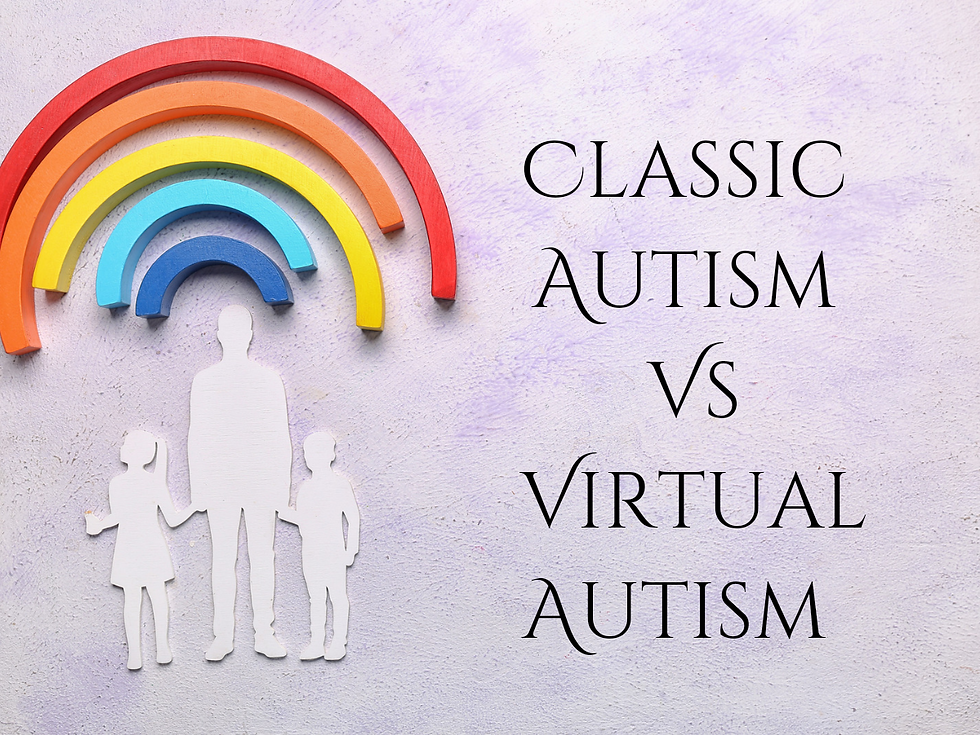A Comprehensive Guide: The Difference Between Classic Autism and Virtual Autism
- Ritu Jain
- Sep 14, 2024
- 4 min read
Autism Spectrum Disorder (ASD) has evolved in its understanding over time, with new concepts like "Virtual Autism" emerging in recent years. While both Classic Autism and Virtual Autism share some behavioral similarities, they have fundamentally different causes and require distinct approaches for intervention. In this guide, we'll explore the key differences between these two conditions, their origins, symptoms, and management strategies.

Definition and Origins of Classic and Virtual Autism
Classic Autism (Kanner's Autism): Classic Autism, the original form of ASD, is a lifelong developmental disorder that primarily affects social interaction, communication, and behavior. It is typically diagnosed in early childhood (usually before the age of 3) and is believed to have a strong genetic component, although environmental factors may play a role. Children with Classic Autism often display repetitive behaviors, significant communication delays, and difficulties understanding social cues (Cross River Therapy, 2023).
Virtual Autism: Coined in recent years, "Virtual Autism" refers to autism-like symptoms that develop in young children due to excessive exposure to screens and limited face-to-face interaction. This term was introduced by Romanian psychologist Dr. Marius Teodor Zamfir, who noticed an increase in ASD-like symptoms in toddlers exposed to over four hours of screen time daily. Unlike Classic Autism, which is thought to be genetically driven, Virtual Autism arises from environmental causes, specifically early and excessive screen use (Rising Above ABA, 2023).
Key Differences in Symptoms of Classic and Virtual Autism
Classic Autism Symptoms: Children with Classic Autism often show signs early in life, such as:
Delayed language development
Repetitive movements (e.g., hand flapping)
Difficulties with eye contact and interpreting social cues
Resistance to changes in routine
Intense focus on specific interests
The symptoms are typically more profound and persist throughout life, although early intervention can help improve communication and adaptive skills (Golden Steps ABA, 2023).
Virtual Autism Symptoms: In contrast, the symptoms of Virtual Autism are linked directly to excessive screen time and can include:
Delayed speech and language development
Reduced eye contact
Attention deficits and hyperactivity
Impaired social interaction due to limited real-life experiences
Short attention spans, possibly due to fast-paced digital stimuli (ABT ABA, 2023).
A crucial distinction is that Virtual Autism symptoms are generally reversible once screen time is reduced, and real-world social interactions are prioritized (Cross River Therapy, 2023).
Causes and Triggers behind Autism
Classic Autism: Classic Autism is believed to stem from genetic factors, with potential environmental triggers like prenatal conditions and early childhood factors exacerbating the severity of symptoms. This type of autism is deeply rooted in the neurodevelopment of the brain, with children often showing symptoms regardless of screen exposure (Golden Steps ABA, 2023).
Virtual Autism: The defining cause of Virtual Autism is excessive screen exposure during critical developmental years (under age 3). Excessive use of digital devices without adequate real-life interaction impairs the child’s ability to develop essential social and communication skills. Key contributing factors include:
Excessive screen time (over 3-4 hours a day)
Lack of face-to-face interactions with caregivers
Limited physical play and sensory experiences (Rising Above ABA, 2023).
Reversibility and Treatment Approaches
Classic Autism Treatment: Classic Autism is a lifelong condition, but early intervention therapies can improve functioning. Common treatments include:
Applied Behavior Analysis (ABA): Focuses on improving communication and social skills while reducing problem behaviors.
Speech and Occupational Therapy: Enhances language development and helps with fine motor skills and sensory integration.
Social Skills Training: Teaches children how to interact more effectively with peers (Golden Steps ABA, 2023). The focus is on long-term support and managing symptoms rather than curing the condition.
Virtual Autism Treatment: The most notable feature of Virtual Autism is that its symptoms are often reversible if addressed early. Key treatment strategies include:

Eliminating or Reducing Screen Time: Studies show significant improvement when screen exposure is reduced or eliminated entirely (Cross River Therapy, 2023).
Increasing Face-to-Face Interaction: Engaging the child in real-world interactions fosters emotional and cognitive development. Activities like group play, storytelling, and sensory-rich environments are essential.
Promoting Physical Activities: Encouraging outdoor play, physical games, and activities that stimulate brain development and fine motor skills help reverse symptoms (Rising Above ABA, 2023).
Structured Early Intervention: Like in Classic Autism, early interventions such as speech and occupational therapies can support development once screen exposure is limited.
Preventive Measures for Virtual Autism
Parents concerned about the impact of excessive screen time should consider proactive measures:
Set Clear Screen Time Limits: The American Academy of Pediatrics recommends no more than one hour of screen time per day for children aged 2 to 5. For younger children, screen use should be avoided whenever possible.
Promote Real-Life Interaction: Encourage social activities that involve interaction with other children, family members, and caregivers to build essential social skills.
Model Healthy Behavior: Children often mimic adults, so parents should set an example by limiting their own screen time and engaging in more interactive and hands-on activities (ABT ABA, 2023).
Provide Sensory-Rich Experiences: Activities like arts and crafts, building blocks, and outdoor exploration foster cognitive and sensory development, essential for preventing autism-like symptoms (Cross River Therapy, 2023).
Conclusion
While both Classic Autism and Virtual Autism exhibit similar behaviors in children, their underlying causes, persistence, and treatments are markedly different. Classic Autism is genetically rooted and requires lifelong management, whereas Virtual Autism is induced by excessive screen time and can often be reversed through lifestyle changes and reduced digital exposure. Understanding these distinctions is key to applying the right interventions and ensuring children develop their social, emotional, and cognitive skills in a healthy, balanced environment.

Comments